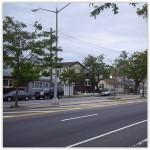 Broad Channel is a neighborhood in the New York City borough of Queens. It occupies the southern portion of Rulers Bar Hassock (known colloquially as “Broad Channel Island”), which is the only inhabited island (pop. about 3,000) in Jamaica Bay. The neighborhood stands on Big Egg Marsh, an area of fill approximately 20 blocks long and 4 blocks wide; the community is an inholding within the Gateway National Recreation Area, a unit of the U.S National Park Service. The area comprises several artificial canals separating dead-end residential blocks. It is connected to the rest of Queens by road and subway bridges.
Broad Channel is a neighborhood in the New York City borough of Queens. It occupies the southern portion of Rulers Bar Hassock (known colloquially as “Broad Channel Island”), which is the only inhabited island (pop. about 3,000) in Jamaica Bay. The neighborhood stands on Big Egg Marsh, an area of fill approximately 20 blocks long and 4 blocks wide; the community is an inholding within the Gateway National Recreation Area, a unit of the U.S National Park Service. The area comprises several artificial canals separating dead-end residential blocks. It is connected to the rest of Queens by road and subway bridges.
HISTORY
In 1915, the city leased the island to the Broad Channel Corporation, which in turn leased properties to private individuals for the development of summer bungalows and houses. The island prospered as an exclusive retreat for city residents. After the construction of the Cross Bay Boulevard in 1923, Broad Channel underwent a surge in popularity.
In 1938, Parks Commissioner Robert Moses wanted to build a park on the island. His plan was for recreation on the shore with a wildlife sanctuary on the north end of the island. In 1939 the Cross Bay Parkway Bridge opened. That same year, the Broad Channel Corporation declared bankruptcy. The city acquired the island’s property titles but, for many years, denied residents the right to purchase the land under their houses. The city made many attempts to alter the island’s purpose, but the local community resisted them all. Proposed changes included the construction of a commercial port and the extension of John F. Kennedy International Airport. In 1982, New York City granted Broad Channel residents the right to purchase their property.
In 1998, Broad Channel’s Labor Day parade received negative media attention after video of a float that parodied the racially motivated dragging death of an African American man was made public. The float carried white men wearing blackface and Afro wigs, and was entitled “Black to the Future – Broad Channel in 2098”. Three white participants on the float, two city firefighters and a city police officer, were later fired from their jobs as a result of the parade incident.They sued the city for wrongful termination, and had their claims upheld in federal district court in 2003. Local residents expressed support for and relief at the ruling, hoping that an end to the court battle would help to rehabilitate the image of the town. The United States Court of Appeals for the Second Circuit reversed the ruling in 2006, holding that the firings could stand.
St. Virgilius School closed in 2006; in 2008, upon the retirement of its administrator, Rev. John P. Maloney, St. Virgilius Parish of Broad Channel merges with St. Camillus Parish of Rockaway Park, New York. Rev. Richard J. Ahlemeyer, pastor of St. Camillus, remains pastor of the new “Parish Family of Saint Camillus – St. Virgilius Roman Catholic Church.”
In August 2011, Broad Channel faced its first mandatory evacuation due to Hurricane Irene. In the aftermath, two homes on Church Road between East 12 & 14th Road collapsed into Jamaica Bay due to the high storm tide. In October 2012, Broad Channel faced another mandatory evacuation; it sustained heavy damage from Hurricane Sandy, with widespread flooding affecting most homes in the area. In subsequent days, widespread prolonged power cuts and shortages of food and water were reported.Press reports indicate that at least parts of the neighborhood are flooded from time to time by high tides. The city has proposed steps (such as raising the streets and sidewalks by three feet), but work has not yet begun.

